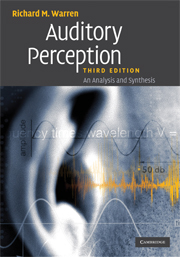Book contents
- Frontmatter
- Contents
- Preface
- 1 Sound and the auditory system
- 2 Spatial localization and binaural hearing
- 3 Perception of acoustic repetition: pitch and infrapitch
- 4 Judging auditory magnitudes: the sone scale of loudness and the mel scale of pitch
- 5 Perception of acoustic sequences
- 6 Perceptual restoration of missing sounds
- 7 Speech
- 8 The relation of hearing to perception in general
- References
- Index
6 - Perceptual restoration of missing sounds
Published online by Cambridge University Press: 18 May 2010
- Frontmatter
- Contents
- Preface
- 1 Sound and the auditory system
- 2 Spatial localization and binaural hearing
- 3 Perception of acoustic repetition: pitch and infrapitch
- 4 Judging auditory magnitudes: the sone scale of loudness and the mel scale of pitch
- 5 Perception of acoustic sequences
- 6 Perceptual restoration of missing sounds
- 7 Speech
- 8 The relation of hearing to perception in general
- References
- Index
Summary
The world is a noisy place, and signals of importance are often accompanied by louder irrelevant sounds. Hearing would lose much of its usefulness could we discern only whichever sound was at the highest level. However, there are mechanisms permitting us to attend to sounds that are fainter. In addition, we can, under certain circumstances, perceptually restore sounds that have been completely obliterated.
Some of the mechanisms enhancing the perception of signals in the presence of interfering sounds have been discussed in Chapter 2. One of these mechanisms squelches or reduces the interference produced by echoes and reverberation through the isolation of the early-arriving components that reach the listener directly from the source. Another mechanism is associated with localization, and reduces the threshold for a sound originating at one place when subject to interference by a sound originating at another position. It is also pointed out in Chapter 2 that contralateral induction can restore monaurally masked signals, and prevent mislocalization of a source.
Nevertheless, signals of importance can still be completely masked and obliterated. But when masking is intermittent, snatches of the signal occurring before and after the obliterated segment can furnish information concerning the missing segments. When this occurs, a perceptual synthesis can allow listeners to perceive the missing sounds as clearly as those actually present. As we shall see, this “temporal induction” of missing fragments can not only result in illusory continuity of steady-state sounds such as tones, but it can also restore contextually appropriate segments of time-varying signals such as speech, melodies, and tone glides.
- Type
- Chapter
- Information
- Auditory PerceptionAn Analysis and Synthesis, pp. 150 - 173Publisher: Cambridge University PressPrint publication year: 2008



